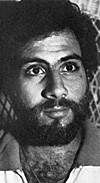 My introduction to formal wargaming came with a trip to the long
since closed Tom Thumb Hobby Shop in Philadelphia. The staff of the
shop, all members of the Miniature Figure Collectors of America
(MFCA), saw my interest and soon had me joining the MFCA. Through
my association with the MFCA, I met Jim Womer, Jay Hadley and
others, and I became firmIy convinced that wargaming was the hobby for me.
My introduction to formal wargaming came with a trip to the long
since closed Tom Thumb Hobby Shop in Philadelphia. The staff of the
shop, all members of the Miniature Figure Collectors of America
(MFCA), saw my interest and soon had me joining the MFCA. Through
my association with the MFCA, I met Jim Womer, Jay Hadley and
others, and I became firmIy convinced that wargaming was the hobby for me.
My earliest armies were 20mm Scruby Ancients, a conglomerate force which included Byzantines, Assyrians and Romans, supported by hundreds of Airfix figures using simple rules adapted from Don Featherstone's Battles with Model Soldiers, my father, a friend from college and I waged many bloodly battles on a ping-pony table, some involving as many as 1200 figures.
Encouraged by my college friend, who now lives in Indiana, my interests expanded to the Renaissance and Colonials. He was an avid Colonial Gamer, and Colonials have remained my second favorite period.
In college, my studies in 17th and 18th century Europe started my deep interest in the warfare of the Renaissance. After reading Machiavelli's The Art of War, I knew that the Renaissance would by my major continuing interest. That was ten years ago, and in that time, I have raised no less than six different Renaissance period armies, ranging from 15mm Mini Figs ECW figures to 40mm Elastolins.
For a couple of years, my cousin and I worked exclusively with Elastolins. However, the number of extreme conversions needed to produce an accurate Renaissance army grew to be an enoumous task. For example, I turned out a troop of Swiss mounted men at arms by using High Medieval Foot Knights, matches and patience.
Today I continue to game primarily solo, though I maintain a continuing dialogue with my friend in Indiana and with members of the MFCA. My Renaissance armies fall into two separate areas, one being late 15th Century Swiss with various German and Burgundian adversaries, and Eastern European games with Poles, Turks, Hungarians and Austrians. I use homemade rules which combine ideas from Gygax's "Chainmail", WRG 1420-1700, Featherstone, and my own inventions. The figures are exclusively 28mm (sic) Hinchcliffe which I feel are about the best Renaissance figures on the market. I also maintain a constantly upgraded library on the Renaissance.
Other than the Renaissance, I am involved in Colonial games, using 30mm Scruby figures, and Larry Brom's excellent rules, "The Sword and The Flame". I am also interested in 18th Century warfare, and skirmish games in a variety of periods. My library, reflecting these other interests, includes several general works on military history along with the Renaissance works.
Through the years, I have constantly worked to improve my painting style and today, using mainly acrylic paints, I feel that my painted figures can hold their own with the best. I also enjoy building houses, forts and other terrain pieces for my table.
I think that my goal in wargaming, if indeed one can really have a goal in a hobby, is to create the most accurate set of rules for the Renaissance possible, reflecting my own perceptions of the period as well as the opinions of others. I would also like to create a workable system for enjoyable solo-play, something which I think is sorely lacking.
Back to Table of Contents -- Courier Vol. III #1
To Courier List of Issues
To MagWeb Master Magazine List
© Copyright 1981 by The Courier Publishing Company.
This article appears in MagWeb (Magazine Web) on the Internet World Wide Web.
Other military history articles and gaming articles are available at http://www.magweb.com